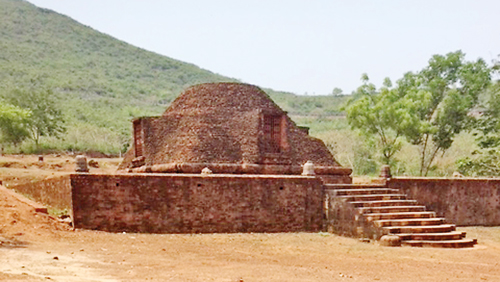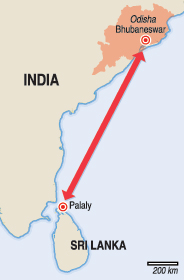So close yet so far: The broken link between Odisha and Sri Lanka
 Can you mark the state of Odisha (formerly Orissa) on a map of India? I can wager that 24 out of 25 Sri Lankans won’t be able to. And yet, there is arguably no other Indian state that has such historical links with Lanka as the State of Odisha.
Can you mark the state of Odisha (formerly Orissa) on a map of India? I can wager that 24 out of 25 Sri Lankans won’t be able to. And yet, there is arguably no other Indian state that has such historical links with Lanka as the State of Odisha.
Sri Lankan history is replete with references to Orissa, that part of East India which is now broken up into three States – Bihar, West Bengal and Odisha (see map).
The links are ancient. According to legend, Prince Vijaya set sail with his band of men to Thambapanni (land of the golden sand) as the island of Lanka was then known from Tamluk, ancient Tamralipti, a port city in present day West Bengal bordering Odisha. And Odisha itself is where the Great Emperor Ashoka fought the last of his battles — at Kalinga. That battle which Ashoka’s army won resulted in the massacre of over 100,000. Viewing the battleground from a nearby hillside, he realised the futility of war and embraced Buddhism that was flourishing in Kalinga at the time, spreading instead the message of universal love. That clash of arms took place in Dhauli only a few kilometres from Odisha’s current state capital of Bhubaneswar. Emperor Ashoka was considered an even more acclaimed warrior than Napoleon or Alexander the Great. His Mauryan Empire spread from present-day India to Afghanistan and almost Iran.
What was remarkable is that he was never defeated in battle, but overcome by his own remorse at blood-letting in the pursuit of glory. Who knows, if not for his change of heart, his next stop may well have been the conquest of Lanka.
Instead, he sent not his Army, but his children, Mahinda with the message of the Buddha Dhamma to Lanka’s King Devanampiyatissa on a Poson Poya day and his daughter Sanghamitta with a Bo sapling from Buddha Gaya. He conquered Lanka in a different way.

Odisha sites: An ancient monastery and right, Buddha statue
Odisha’s Buddhist history has only really been officially rediscovered due to the work of Universities, and also the Archaeological Survey of India. In Udayagiri, Ratnagiri and Lalithgiri, known as the Diamond Triangle are numerous archaeological sites and monasteries so much so it was hailed as a centre of learning second only to the iconic Nalanda University in fairly close proximity to Buddha Gaya in which there is renewed international interest as one of the greatest seats of learning of all time.
Odisha’s sites, which also include the ancient Buddhist sites in Puri have yet to receive due recognition from the State Government leave alone the Government of India or of international governments and UN agencies like UNESCO.
 While the Odisha State government advertises its tourism attractions over CNN, it has to upgrade its vast potential in ‘Buddhism tourism’. It has failed to exploit the historical story of Emperor Ashoka who pioneered the change in the course of Indian history from that of conquest to one of love. The famed rock edict in Dhauli which Ashoka inscribed in Brahmi script is kept locked in a seemingly makeshift shed, opened by a watcher for a small tip. There are around 30 edicts of Ashoka in different parts of India, several of them found in Dhauli and Jaugada both in Odisha.
While the Odisha State government advertises its tourism attractions over CNN, it has to upgrade its vast potential in ‘Buddhism tourism’. It has failed to exploit the historical story of Emperor Ashoka who pioneered the change in the course of Indian history from that of conquest to one of love. The famed rock edict in Dhauli which Ashoka inscribed in Brahmi script is kept locked in a seemingly makeshift shed, opened by a watcher for a small tip. There are around 30 edicts of Ashoka in different parts of India, several of them found in Dhauli and Jaugada both in Odisha.
The Japanese built a peace pagoda near the banks of the river Daya in 1972 to commemorate Asoka’s change of heart after the Kalinga war– the Dhauli International Peace Pagoda or Dhauli Giri Shanti Stupa and that is the only proper place for visitors to come and spend a morning.

Ashoka’s edict inscribed on rock
Today, Odisha’s sea routes have gone into disuse. The Bhubaneswar airport largely caters to domestic travellers. Only Thai Airways flies in from overseas, given its Buddhist history. SriLankan Airlines flies to dozens of destinations in India a week but there’s no direct flight to Bhubaneswar, which should take just over an hour’s flying time from Colombo.
If Palaly airport is opened one day for regional flights it should take less than an hour to Bhubaneswar from there.
The other day the PM’s official website quoted Premier Ranil Wickremesinghe referring to the impact of Emperor Ashoka in a speech made at the foundation stone laying ceremony of the Postgraduate Institute of Pali and Buddhist Studies at the Kelaniya University. “Emperor Ashoka of India disseminated Buddhist missionaries extending to Greece, Egypt and Iran for the propagation of Buddhism. They used the Greek and the Egyptian languages in the propogation of the Dhamma. We have to take these examples and move forward.”
Both the Government of Sri Lanka and the State Government of Odisha must join hands in restoring the ties between the peoples, the cultures and historical links. The Congress spokesman in Odisha said that out of 100 Sinhala words, 34 have their origin in Odia, the language of Odisha.
This forgotten history has to be reconnected as both Sri Lanka and Odisha have been engrossed in their own politics over the years. The two are so close, yet so far.


